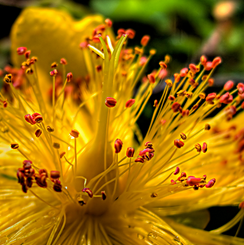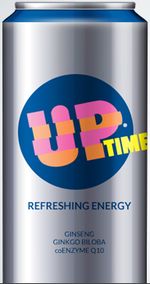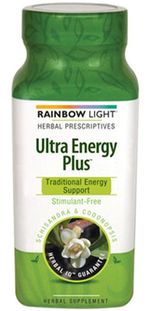 Many people suffer from symptoms of minor depression sometime in their life. Persistent sadness, moodiness, lethargy, tiredness, or suicidal thoughts can all be signs that you’re in the grips of depression. What can you do? Historically, the recommended treatment has been to take drugs such as Prozac or Zoloft—sometimes coupled with therapy. Yet, these medications present a problem for many people. First of all, getting a prescription and buying these medications can cost hundreds of dollars. Secondly, many people find that anti-depressant medications don’t work at all or they can cause unpleasant side effects. Fortunately, some people can overcome depression naturally. An inexpensive and safe alternative to anti-depressant medications has recently become popular; it’s called Hypericum—but it’s better known as St. John’s Wort.
Many people suffer from symptoms of minor depression sometime in their life. Persistent sadness, moodiness, lethargy, tiredness, or suicidal thoughts can all be signs that you’re in the grips of depression. What can you do? Historically, the recommended treatment has been to take drugs such as Prozac or Zoloft—sometimes coupled with therapy. Yet, these medications present a problem for many people. First of all, getting a prescription and buying these medications can cost hundreds of dollars. Secondly, many people find that anti-depressant medications don’t work at all or they can cause unpleasant side effects. Fortunately, some people can overcome depression naturally. An inexpensive and safe alternative to anti-depressant medications has recently become popular; it’s called Hypericum—but it’s better known as St. John’s Wort.
How to Overcome Depression Without Medication.
St. John’s Wort is derived from a yellow-flowered plant that has been ingested around the world for some 2,000 years. In 1994, the venerable Journal of Geriatric Psychiatry and Neurology devoted an entire issue to Hypericum. One study done with 3,250 patients suffering from mild and moderate depression found that 80 percent of them felt better, or completely free of symptoms, after four weeks. In Germany St. John’s Wort is the leading treatment for depression and is prescribed 25 times more frequently than Prozac. Best of all, St. John’s Wort can be picked up at your local health food store without a prescription, and costs a lot less than any anti-depressant on the market.
Although more research needs to be done on Hypericum/St. John’s Wort, by all accounts it is a great way for overcoming depression without traditional medications. Approximately 2.4% of those trying the herb experience side effects—ranging from restlessness to mild allergic reactions. The percentage of people who report side effects from Prozac or Zoloft is markedly higher. For example, approximately 20% of people who take Prozac experience headache, digestive difficulties and/or insomnia. While Hypericum may make some people sensitive to the sun, the absence of serious side effects is one of its biggest selling points.
If you suffer from mild or moderate depression from time to time
consider trying  Hypericum as a way to overcome depression naturally. The recommended dosage is 300 milligrams of Hypericum extract, containing 0.3 percent of the active ingredient Hypericum, three times a day. It takes between one and four weeks for the herb to start working. Since it takes awhile for this medicine to have an effect, avoid trying it in response to momentary sadness or lethargy. Yet, if you feel depressed for several weeks, there is little to risk and potentially a lot to gain from trying St. John’s Wort.
Hypericum as a way to overcome depression naturally. The recommended dosage is 300 milligrams of Hypericum extract, containing 0.3 percent of the active ingredient Hypericum, three times a day. It takes between one and four weeks for the herb to start working. Since it takes awhile for this medicine to have an effect, avoid trying it in response to momentary sadness or lethargy. Yet, if you feel depressed for several weeks, there is little to risk and potentially a lot to gain from trying St. John’s Wort.
Due to the fact that I’m a therapist and not a psychiatrist, I’m not able to prescribe medication. Frequently, clients would come to my office feeling depressed, but they lacked the funds to see a psychiatrist. In addition, some clients simply refused to take drugs such as Prozac because they didn’t like the side effects or how it made them feel. When I heard about Hypericum, I began suggesting it to clients I thought could benefit from its use. In almost every case, glowing reports came back to me. Many of the clients who had previously taken anti-depressants reported they liked Hypericum better. Several of my clients said they experienced fewer side effects and/or found it to feel “more natural” than the previous medications they had tried.
If you try Hypericum or other anti-depressant remedies,
it’s important not to use them to avoid looking at important issues in your life. Depression can often be a sign that certain aspects of your life are not working. A good therapist or a good book that deals with a therapeutic approach to depression can be an important part of your recovery; the book Feeling Good by Dr. David Burns is a good place to start. Although psychotherapy can be expensive, it can beat the cost of spending the rest of your life running from yourself. If you decide to try therapy as part of your treatment, ask friends if they know of anyone they can recommend. Another option is to call several therapists and talk to each of them on the phone to see which one feels right for you.
 Hypericum is not a cure-all for depression and sadness. Yet, for many people it can be an enormous help. If, after using Hypericum for four to six weeks, you don’t notice any improvement, consider seeing a psychiatrist for his or her recommendation. If you keep trying new medications and/or forms of therapy, you’ll eventually find something that helps. Don’t give up hope. Even severely depressed people have been known to bounce back to a feeling of contentment after finding a treatment that was right for them. Good luck on your search
Hypericum is not a cure-all for depression and sadness. Yet, for many people it can be an enormous help. If, after using Hypericum for four to six weeks, you don’t notice any improvement, consider seeing a psychiatrist for his or her recommendation. If you keep trying new medications and/or forms of therapy, you’ll eventually find something that helps. Don’t give up hope. Even severely depressed people have been known to bounce back to a feeling of contentment after finding a treatment that was right for them. Good luck on your search


 I used to suffer greatly from a bad case of self-criticism, in my teenage years, it was so severe that I could never ask a girl out on a date. I feared that she’d say “no” and I’d end up spending the next week getting down on myself for my failure.
I used to suffer greatly from a bad case of self-criticism, in my teenage years, it was so severe that I could never ask a girl out on a date. I feared that she’d say “no” and I’d end up spending the next week getting down on myself for my failure. What would it be like if you found out that you had a million dollars in a secret bank account, but you didn’t know it? Wouldn’t that be great? Well, in a certain way you do. You have enormous riches locked within you in the form of positive feelings—such as love, gratitude, compassion, and joy. The problem is, most people haven’t known how to access these feelings. Yet, the new field of
What would it be like if you found out that you had a million dollars in a secret bank account, but you didn’t know it? Wouldn’t that be great? Well, in a certain way you do. You have enormous riches locked within you in the form of positive feelings—such as love, gratitude, compassion, and joy. The problem is, most people haven’t known how to access these feelings. Yet, the new field of  I sell (for very little money I might add), a systematic course in teaching people the best and most powerful ways to quickly boost their level of happiness. There are over 30 methods in my Deeper Happiness course that have been shown to boost people’s level of happiness, and most of them take under three minutes a day to do. That’s great news. It’s like learning you had a million dollars lying around in the bank, but you didn’t know it.
I sell (for very little money I might add), a systematic course in teaching people the best and most powerful ways to quickly boost their level of happiness. There are over 30 methods in my Deeper Happiness course that have been shown to boost people’s level of happiness, and most of them take under three minutes a day to do. That’s great news. It’s like learning you had a million dollars lying around in the bank, but you didn’t know it. Although such books contain valuable information, virtually no one uses what they read from books in a systematic manner in their daily life. It’s just too big of a jump. What’s needed is a simple, almost automatic way to be reminded to use Positive Psychology exercises in daily life.
Although such books contain valuable information, virtually no one uses what they read from books in a systematic manner in their daily life. It’s just too big of a jump. What’s needed is a simple, almost automatic way to be reminded to use Positive Psychology exercises in daily life. You are living in a dangerous cult. I mean it. Of course, like most people in cults, you don’t think it’s dangerous—or that it’s even a cult. This “cult” that you (and I) are living in is the hyper capitalist economic system of modern day life.
You are living in a dangerous cult. I mean it. Of course, like most people in cults, you don’t think it’s dangerous—or that it’s even a cult. This “cult” that you (and I) are living in is the hyper capitalist economic system of modern day life. happiness that we are all on, you can’t assume anything that you’ve heard. Unfortunately, our culture is constantly pushing its ideas about finding the “good life” onto us, and that brainwashing does not necessarily have anything to do with being happy. After all, does Donald Trump look joyous to you? In the last twenty years, the average GDP of Chinese citizens has gone up 400%, and yet their average level of happiness has actually gone down.
happiness that we are all on, you can’t assume anything that you’ve heard. Unfortunately, our culture is constantly pushing its ideas about finding the “good life” onto us, and that brainwashing does not necessarily have anything to do with being happy. After all, does Donald Trump look joyous to you? In the last twenty years, the average GDP of Chinese citizens has gone up 400%, and yet their average level of happiness has actually gone down. Here’s just one example. Highly contented people tend to schedule time each week for activities they truly enjoy. On the other hand, unhappy people tend to make excuses as to why they don’t have time for what they really like to do. Here’s another example. Happy people make being with friends and enjoying life a central priority in their life, whereas less contented folks make things like making money their main priority.
Here’s just one example. Highly contented people tend to schedule time each week for activities they truly enjoy. On the other hand, unhappy people tend to make excuses as to why they don’t have time for what they really like to do. Here’s another example. Happy people make being with friends and enjoying life a central priority in their life, whereas less contented folks make things like making money their main priority. that the American Dream is actually a repetitive, busy, and not too unpleasant nightmare. I soon realized that always striving for more, always being busy, and constantly competing for recognition was not a path to greater peace of mind. As I began to see through the brainwashing of Western culture, I began to notice what really made me happy. What really made me happy wasn’t having bouncy hair, a big house, or a Mercedes. It ends up it was little moments of depth and joy I could find in everyday life. Nowadays, I spend more time playing with my dog, watching sunsets, hanging out with my friends, reading great books, and meditating.
that the American Dream is actually a repetitive, busy, and not too unpleasant nightmare. I soon realized that always striving for more, always being busy, and constantly competing for recognition was not a path to greater peace of mind. As I began to see through the brainwashing of Western culture, I began to notice what really made me happy. What really made me happy wasn’t having bouncy hair, a big house, or a Mercedes. It ends up it was little moments of depth and joy I could find in everyday life. Nowadays, I spend more time playing with my dog, watching sunsets, hanging out with my friends, reading great books, and meditating.
 What do you absolutely love to do? It need not be a big thing. Perhaps you really love to watch football, or maybe you really enjoy baking your own bread. Often, we get so caught up in living our life that we forget to take time for life’s simple pleasures. Many people find that their life is so full of responsibilities that they rarely take time for fun and adventure. If that sounds like you, then you’ll benefit by using the “Pain and Pleasure List.” The Pain and Pleasure List is a catalog of at least ten things you enjoy doing and a list of ten things you don’t particularly care for. It helps you clarify what really turns you on in life and what you do only because you have to – or think you should. While we all need to do things we don’t like from time to time, life is not meant to be a series of burdens and responsibilities. By having a Pain and Pleasure List, you’ll be able to make important changes in your life with a lot more ease.
What do you absolutely love to do? It need not be a big thing. Perhaps you really love to watch football, or maybe you really enjoy baking your own bread. Often, we get so caught up in living our life that we forget to take time for life’s simple pleasures. Many people find that their life is so full of responsibilities that they rarely take time for fun and adventure. If that sounds like you, then you’ll benefit by using the “Pain and Pleasure List.” The Pain and Pleasure List is a catalog of at least ten things you enjoy doing and a list of ten things you don’t particularly care for. It helps you clarify what really turns you on in life and what you do only because you have to – or think you should. While we all need to do things we don’t like from time to time, life is not meant to be a series of burdens and responsibilities. By having a Pain and Pleasure List, you’ll be able to make important changes in your life with a lot more ease. The first step in using the Pain and Pleasure List is to simply create it. The singular act of writing down ten things you love to do and ten things you don’t care for can reveal a lot about your life. Recently, a client named James made his list while in my office. He had originally come to see me because of depression, stress at work, and problems with his wife. This was the list he created:
The first step in using the Pain and Pleasure List is to simply create it. The singular act of writing down ten things you love to do and ten things you don’t care for can reveal a lot about your life. Recently, a client named James made his list while in my office. He had originally come to see me because of depression, stress at work, and problems with his wife. This was the list he created: on the “pain” side of the list was a whopping 215 hours per month. The total number of hours on the “pleasure” side of the list was a meager 32 hours a month. That’s almost a seven-to-one ratio of pain to pleasure. I’ve found that when the degree of pain as compared to pleasure rises above a five-to-one ratio, people dislike their life. In order to feel good again, such people need to spend less time doing “painful” activities, and more time doing what they enjoy.
on the “pain” side of the list was a whopping 215 hours per month. The total number of hours on the “pleasure” side of the list was a meager 32 hours a month. That’s almost a seven-to-one ratio of pain to pleasure. I’ve found that when the degree of pain as compared to pleasure rises above a five-to-one ratio, people dislike their life. In order to feel good again, such people need to spend less time doing “painful” activities, and more time doing what they enjoy. Although less frequently, some people who complete the Pain and Pleasure List see a pattern of having too much pleasure in their life. They tend to avoid responsibilities and discipline at all costs. Unfortunately, this form of hedonism doesn’t work well long term. By avoiding difficult things now, people with this predilection often create problems in their finances and relationships later on. The key to having a successful life is to find the right balance of pain to pleasure. It must be a balance that works, not only in one’s current life, but it must also work long term.
Although less frequently, some people who complete the Pain and Pleasure List see a pattern of having too much pleasure in their life. They tend to avoid responsibilities and discipline at all costs. Unfortunately, this form of hedonism doesn’t work well long term. By avoiding difficult things now, people with this predilection often create problems in their finances and relationships later on. The key to having a successful life is to find the right balance of pain to pleasure. It must be a balance that works, not only in one’s current life, but it must also work long term. If your life is at all like mine, it’s both busy and stressful. Most people handle the onslaught of stress they face by taking periodic vacations to recover from their life. While vacations are a good idea, you can’t take one every time your life becomes hectic. In addition, taking a weekend or a week off to go to Hawaii doesn’t help you to know how to relax when you’re back in the rat race. What’s needed is a simple way to let go of stress and know how to relax that can be done while you’re still in the stressful situation—not five days later. That’s why I created the One-Breath Technique. In twenty to sixty seconds of doing this powerful method, you can experience how to relax bodily tensions, as well as let go of negative emotions and useless anxiety. It’s a wonderful gift to give yourself.
If your life is at all like mine, it’s both busy and stressful. Most people handle the onslaught of stress they face by taking periodic vacations to recover from their life. While vacations are a good idea, you can’t take one every time your life becomes hectic. In addition, taking a weekend or a week off to go to Hawaii doesn’t help you to know how to relax when you’re back in the rat race. What’s needed is a simple way to let go of stress and know how to relax that can be done while you’re still in the stressful situation—not five days later. That’s why I created the One-Breath Technique. In twenty to sixty seconds of doing this powerful method, you can experience how to relax bodily tensions, as well as let go of negative emotions and useless anxiety. It’s a wonderful gift to give yourself. I created the One-Breath Technique when I noticed how frequently something makes me impatient, uptight, or annoyed during the day. Without something to interrupt my stress, my minor upsets often snowballed into a momentum of negativity. Rather than using a technique that required taking several minutes away from the situation at hand, I saw the value of learning how to relax right in the moment. The One Breath Technique can be done almost anywhere and, with practice, won’t even be noticeable by others. Despite its brevity, it can effectively interrupt the build-up of stress and frustration that can so easily happen in modern day life.
I created the One-Breath Technique when I noticed how frequently something makes me impatient, uptight, or annoyed during the day. Without something to interrupt my stress, my minor upsets often snowballed into a momentum of negativity. Rather than using a technique that required taking several minutes away from the situation at hand, I saw the value of learning how to relax right in the moment. The One Breath Technique can be done almost anywhere and, with practice, won’t even be noticeable by others. Despite its brevity, it can effectively interrupt the build-up of stress and frustration that can so easily happen in modern day life. The first step in doing the One Breath Technique is to become aware that you’re stressed, upset, or could benefit from a mini-relaxation break. Next, observe the location in your body that you feel the most tightness or discomfort. For many people, they feel stress most noticeably in their shoulders, their chest, or their stomach area. Some people feel tension in many parts of their body simultaneously. Wherever you feel stress the most, imagine inhaling pure, soothing air into that area. Breathe as deeply as you can, first filling up your abdomen with air, then your chest. Once you’ve taken in as much air as you can, hold your breath for ten seconds.
The first step in doing the One Breath Technique is to become aware that you’re stressed, upset, or could benefit from a mini-relaxation break. Next, observe the location in your body that you feel the most tightness or discomfort. For many people, they feel stress most noticeably in their shoulders, their chest, or their stomach area. Some people feel tension in many parts of their body simultaneously. Wherever you feel stress the most, imagine inhaling pure, soothing air into that area. Breathe as deeply as you can, first filling up your abdomen with air, then your chest. Once you’ve taken in as much air as you can, hold your breath for ten seconds. During the time that you’re holding your breath, attempt to tighten all the areas of your body that feel stressed. For example, if your shoulders are tight, tense them even more —perhaps by bringing them closer to your ears. If your stomach feels uncomfortable, tense the muscles in that area (while you hold your breath)—as if you’re preparing for someone to hit you in the belly. At the end of your ten count of tightening muscles and holding your breath, it’s time for you to fully relax. How to relax is key. Let go of your breath with a long, slow sighing sound (if you’re in a place where making a sound is okay). While you’re letting go of your muscles and your breath, think to yourself, “Let it all go,” or some other simple phrase that works for you. When you relax your muscles and your breath, you’ll notice a warm feeling of relaxation traveling through your body. Focus on the tingling warm sensations as they move through you. Notice if there are any parts of your body that still feel tight, and if so, try to let them go as well. Although it’s called the One-Breath Technique, you’re welcome to do it once or twice more if you need to, and if you have the time.
During the time that you’re holding your breath, attempt to tighten all the areas of your body that feel stressed. For example, if your shoulders are tight, tense them even more —perhaps by bringing them closer to your ears. If your stomach feels uncomfortable, tense the muscles in that area (while you hold your breath)—as if you’re preparing for someone to hit you in the belly. At the end of your ten count of tightening muscles and holding your breath, it’s time for you to fully relax. How to relax is key. Let go of your breath with a long, slow sighing sound (if you’re in a place where making a sound is okay). While you’re letting go of your muscles and your breath, think to yourself, “Let it all go,” or some other simple phrase that works for you. When you relax your muscles and your breath, you’ll notice a warm feeling of relaxation traveling through your body. Focus on the tingling warm sensations as they move through you. Notice if there are any parts of your body that still feel tight, and if so, try to let them go as well. Although it’s called the One-Breath Technique, you’re welcome to do it once or twice more if you need to, and if you have the time. Part of the beauty of this technique is its simplicity. In less than a minute, you can interrupt your stressful reactions that can lead to a bad day, bad health, and ultimately, a bad time in life. Fortunately, because it is brief and can even be invisible to the people around you, there is no good reason not to use it. In fact, why not try it right now? I mean it. If you like it, perhaps you’ll get in the One-Breath habit. It’s one of the healthiest habits you’ll ever have. Right now would be an excellent time to begin… Once you’ve mastered that, check out all my other
Part of the beauty of this technique is its simplicity. In less than a minute, you can interrupt your stressful reactions that can lead to a bad day, bad health, and ultimately, a bad time in life. Fortunately, because it is brief and can even be invisible to the people around you, there is no good reason not to use it. In fact, why not try it right now? I mean it. If you like it, perhaps you’ll get in the One-Breath habit. It’s one of the healthiest habits you’ll ever have. Right now would be an excellent time to begin… Once you’ve mastered that, check out all my other  Have you ever felt depressed and filled with enormous amounts of energy at the same time? Probably not. When we have a lot of energy, we both feel better and get more done. Of course, we’re told that the way to greater vim and vigor is to eat right, exercise, and avoid harmful substances. We know what we should do, but we often don’t have the energy or discipline to follow through. If you’re like me, you wonder “are there any safe shortcuts to how to have more energy?” Luckily, there are. There are now a plethora of supplements in health food stores that can safely and effectively help you to get more energy. Once you find how to get more energy in a way that works well for you, it’s like finding a magic pill that helps you feel healthier, happier, and more energized. Who knows, you may even become motivated to eat better and exercise more often!
Have you ever felt depressed and filled with enormous amounts of energy at the same time? Probably not. When we have a lot of energy, we both feel better and get more done. Of course, we’re told that the way to greater vim and vigor is to eat right, exercise, and avoid harmful substances. We know what we should do, but we often don’t have the energy or discipline to follow through. If you’re like me, you wonder “are there any safe shortcuts to how to have more energy?” Luckily, there are. There are now a plethora of supplements in health food stores that can safely and effectively help you to get more energy. Once you find how to get more energy in a way that works well for you, it’s like finding a magic pill that helps you feel healthier, happier, and more energized. Who knows, you may even become motivated to eat better and exercise more often! Bearing all this information in mind, there are several supplements I can heartily recommend because of their ingredients and the consistently good results people report. My personal favorite is something called
Bearing all this information in mind, there are several supplements I can heartily recommend because of their ingredients and the consistently good results people report. My personal favorite is something called 
 The great thing about finding a Magic Pill or drink to get more energy is how easy it is. No matter how lazy you are, you can always pop a pill into your mouth or drink some fresh juices. Although supplements are easy to “use,” their effect can be life transforming. Many people don’t realize that the reason they feel depressed or unhealthy is due to a lack of nutrients. I’ve seen clients in my therapy practice who literally change overnight by finding a supplement they really needed to take. Once you know how to get more energy in a way that feels good to your body, you’ll have a consistent way to support your body, mind, and spirit. With a little exploring, for under a dollar a day, you can find a supplement that can have a major impact on your life. That’s a deal too good to refuse.
The great thing about finding a Magic Pill or drink to get more energy is how easy it is. No matter how lazy you are, you can always pop a pill into your mouth or drink some fresh juices. Although supplements are easy to “use,” their effect can be life transforming. Many people don’t realize that the reason they feel depressed or unhealthy is due to a lack of nutrients. I’ve seen clients in my therapy practice who literally change overnight by finding a supplement they really needed to take. Once you know how to get more energy in a way that feels good to your body, you’ll have a consistent way to support your body, mind, and spirit. With a little exploring, for under a dollar a day, you can find a supplement that can have a major impact on your life. That’s a deal too good to refuse. March 20th is the International Day of Happiness, which is sponsored by the United Nations. They ask all participants to make the following pledge:
March 20th is the International Day of Happiness, which is sponsored by the United Nations. They ask all participants to make the following pledge: I believe that happiness is our natural state. Look at young kids. They are happy a lot (unless they are in physical pain), so it can’t be something we need to learn “to do.” Instead, we have to focus on what it is we are already doing that gets in the way of our natural joy, peace, and contentment. Rather than just have this be a theoretical discussion, you can ask that question to yourself. What do you think you do that gets in the way of you being happier?
I believe that happiness is our natural state. Look at young kids. They are happy a lot (unless they are in physical pain), so it can’t be something we need to learn “to do.” Instead, we have to focus on what it is we are already doing that gets in the way of our natural joy, peace, and contentment. Rather than just have this be a theoretical discussion, you can ask that question to yourself. What do you think you do that gets in the way of you being happier? But the truth is that you and I are doing specific things almost all the time that get in the way of being truly joyous—and most of us have no idea what those self-destructive habits are! We fall victim to bad habits like rushing, multitasking, worrying, or indulging in negative emotion patterns. All these “inner” obstacles keep us from being happier—and they even keep us from attempting to make others happier. Only by becoming aware of our inner obstacles to being happier or being kinder can we make a significant impact in our level of fulfillment.
But the truth is that you and I are doing specific things almost all the time that get in the way of being truly joyous—and most of us have no idea what those self-destructive habits are! We fall victim to bad habits like rushing, multitasking, worrying, or indulging in negative emotion patterns. All these “inner” obstacles keep us from being happier—and they even keep us from attempting to make others happier. Only by becoming aware of our inner obstacles to being happier or being kinder can we make a significant impact in our level of fulfillment. The first step is to become acutely aware of what specific things you do that lead away from your natural state of happiness. In my audio course, Deeper Happiness: One Month to a Lifetime of Greater Fulfillment, I have many simple methods for doing that. But here’s one simple idea you can try: On the International Day of Happiness, March 20th, try a one day experiment. For one day, do your absolute best to be ridiculously happy. If you need to, fake it till you make it. While you’re at it, do your best to make others happy as well. Then, notice what thought patterns, emotions, or daily habits get in the way of you being truly and consistently happy that day.
The first step is to become acutely aware of what specific things you do that lead away from your natural state of happiness. In my audio course, Deeper Happiness: One Month to a Lifetime of Greater Fulfillment, I have many simple methods for doing that. But here’s one simple idea you can try: On the International Day of Happiness, March 20th, try a one day experiment. For one day, do your absolute best to be ridiculously happy. If you need to, fake it till you make it. While you’re at it, do your best to make others happy as well. Then, notice what thought patterns, emotions, or daily habits get in the way of you being truly and consistently happy that day. In my opinion, there is nothing more important in life than trying to be happy and add to the level of happiness in the world. The good news is that, as a race, we’re currently pretty bad at being happy. I say that’s good news because, with a little effort and experimentation, we’re bound to get better at it. Fortunately, there are a lot of simple methods that can help us on the path towards deeper happiness. For instance, the attitude that you’re a detective on the look out for what gets in the way of being happy is a good start. I encourage you to keep that in mind on March 20th—the International Day of Happiness. By experimenting with your own desire to be a more fulfilled person, you will also be helping others to reach their full potential.
In my opinion, there is nothing more important in life than trying to be happy and add to the level of happiness in the world. The good news is that, as a race, we’re currently pretty bad at being happy. I say that’s good news because, with a little effort and experimentation, we’re bound to get better at it. Fortunately, there are a lot of simple methods that can help us on the path towards deeper happiness. For instance, the attitude that you’re a detective on the look out for what gets in the way of being happy is a good start. I encourage you to keep that in mind on March 20th—the International Day of Happiness. By experimenting with your own desire to be a more fulfilled person, you will also be helping others to reach their full potential.



 We all want to experience deeper peace in our lives, or simply have more joy. As a teacher of workshops on happiness, I’ve looked for quick ways to help people quiet their minds and/or enjoy more fun and play. Of the many different things I’ve tried, I’ve found one formula to be so simple and effective that I heartily recommend it to everyone. I call this method The Magical Playlist.
We all want to experience deeper peace in our lives, or simply have more joy. As a teacher of workshops on happiness, I’ve looked for quick ways to help people quiet their minds and/or enjoy more fun and play. Of the many different things I’ve tried, I’ve found one formula to be so simple and effective that I heartily recommend it to everyone. I call this method The Magical Playlist. Of all the possessions I own, my iPod is my most treasured. By listening to certain songs, I have almost immediate access to any feeling I want—without any cost, and no known side effects! When making certain playlists, I looked through all the songs I have on my computer, and carefully selected songs that have always had the most impact on me. Nowadays, I have special “mood altering” playlists categorized in five different ways: First, songs that put me in a fun and happy mood. In this category, I have songs like “Twist and Shout” and “I Wanna Hold Your Hand” by the Beatles. It’s hard to sing along with such songs without getting a smile on your face. Try it and you’ll see what I mean.
Of all the possessions I own, my iPod is my most treasured. By listening to certain songs, I have almost immediate access to any feeling I want—without any cost, and no known side effects! When making certain playlists, I looked through all the songs I have on my computer, and carefully selected songs that have always had the most impact on me. Nowadays, I have special “mood altering” playlists categorized in five different ways: First, songs that put me in a fun and happy mood. In this category, I have songs like “Twist and Shout” and “I Wanna Hold Your Hand” by the Beatles. It’s hard to sing along with such songs without getting a smile on your face. Try it and you’ll see what I mean. My fourth “magical” playlist includes songs that make me feel energized and motivated. These are songs I like to shout to, like Bruce Springsteen’s “Born to Run,” or U2’s “Vertigo.” After shouting to a couple of songs on this playlist, I feel like I can tackle anything. Finally, I have a playlist of songs that make me feel all lovey and mushy inside. These songs are great to listen to before you spend time with your mate or a date.
My fourth “magical” playlist includes songs that make me feel energized and motivated. These are songs I like to shout to, like Bruce Springsteen’s “Born to Run,” or U2’s “Vertigo.” After shouting to a couple of songs on this playlist, I feel like I can tackle anything. Finally, I have a playlist of songs that make me feel all lovey and mushy inside. These songs are great to listen to before you spend time with your mate or a date.